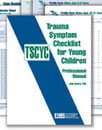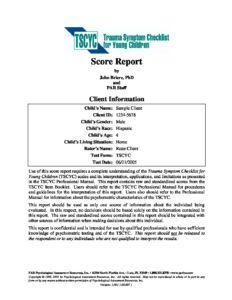
Trauma Symptom Checklist for Young Children tscyc
For: Evaluate acute and chronic post-traumatic symptomatology in ages 3 to 12 years
Reading Level: Preschool - Child
Format: Paper and pencil; Online administration and scoring via PARiConnect; or PC Based Software
Length: 15-20 minutes
Scoring: Hand Scored; PC Based Software; or online via PARiConnect
Online Forms, Reports, Kits & e-Manuals
All online resources including Forms, Reports, i-Admins, Kits and e-Manuals.
Printed Forms & Handscoring Materials
Test forms, response booklets and scoring reference manuals.
Books & Workbooks
Click to browse products
Printed Kits
Click to browse products
Printed Manuals
Physical printed manuals.
TSCYC e-Manual
TSCYC online Score Report (each) min order 5
TSCYC online i-Admin (each) min order 5
TSCYC-SF online Screening Form Score Report (each) min order 5
TSCYC-SF online Screening Form i-Admin (each) min order 5
TSCYC Hand Scorable Answer Sheets (25)
TSCYC Profile Forms-Male & Female Ages 10-12 Years
TSCYC Profile Forms-Male & Female Ages 3-4 Years (25)
TSCYC Profile Forms-Male & Females Ages 5-9 Years
TSCYC Reusable Item Booklets (25)
TSCYC Screening Form Hand-Scorable Answer Sheets (pkg/25)
TSCYC Screening Form Hand-Scorable Answer Sheets (pkg/25)
TSCYC Introductory Kit
TSCYC Screening Form Introductory Kit
TSCYC Professional Manual
Contact PAA today to set up your PARiConnect online account to utilise online administration, scoring and reporting.
Author
John Briere, PhD
Description
Because exposure to traumatic events (e.g. child abuse, peer assaults, community violence) is an unfortunate part of many children’s lives, psychological tests for trauma effects have become an important part of the child-focused assessment battery. Following the success of the Trauma Symptom Checklist for Children (TSCC) in evaluating older children (ages 8 to 16 years), the new Trauma Symptom Checklist for Young Children (TSCYC) is the first fully standardised and normed broadband trauma measure for children as young as age 3 years.
Eight years in the making, and tested by clinicians and researchers throughout North America, the TSCYC is a 90-item caretaker-report instrument, with separate norms for males and females in three age groups: 3-4 years, 5-9 years, and 10-12 years. Caretakers rate each symptom on a 4-point scale according to how often the symptom has occurred in the previous month. Unlike most other caretaker-report measures, the TSCYC contains specific scales to ascertain the validity of caretaker reports (Response Level and Atypical Response), as well as providing norm-referenced data on the number of waking hours the caretaker spends with the child in the average week (0-1 hours to Over 60 hours).
The TSCYC contains eight Clinical scales: Anxiety, Depression, Anger/Aggression, Post-traumatic Stress-Intrusion, Post-traumatic Stress-Avoidance, Post-traumatic Stress-Arousal, Dissociation and Sexual Concerns, as well as a summary post-traumatic stress scale (Post-traumatic Stress-Total). These scales provide a detailed evaluation of post-traumatic stress, as well as information on other symptoms found in many traumatised children. The PTSD Diagnosis Worksheet incorporates information from the TSCYC to assist the user in evaluating PTSD criteria in younger children, and provides a possible PTSD diagnosis in children ages 5 years or older (sensitivity = .72, specificity = .75). The TSCYC is appropriate for English-speaking caretakers, including those who have a relatively low reading level (Flesch-Kincade score = 6.8).
The TSCYC materials consist of the Professional Manual, Item Booklet, Answer Sheet, and age- and gender-specific Profile Forms. Once the TSCYC is administered to the caretaker, the Answer Sheet is hand-scored by the examiner using the Scoring Sheet and the PTSD Diagnosis Worksheet. Resulting raw scores are converted and plotted as T scores, depending on the child’s gender and age. The PTSD Diagnosis Worksheet aids the user in ascertaining the PTSD status of the child according to the DSM-IV-TR. The Professional Manual includes several examples of how to score and interpret the TSCYC.
Norms are based on a stratified national standardisation sample of 750 children.
Internal consistency for the Clinical scales in the standardisation sample ranged from .78-.92, with an average clinical alpha coefficient of .86. Similar results were found in clinical and child abuse treatment samples.
Homogeneity-corrected test-retest correlation coefficients for TSCYC scales ranged from .68-.96, with a median coefficient of .88.
Discriminant, predictive, and construct validity have been demonstrated for the TSCYC in multiple samples and studies.
Different TSCYC scale patterns have been found to predict different forms of trauma exposure in a published study of traumatised children.
Now available! The TSCYC Screening Form allows you to quickly screen for posttraumatic stress and related psychological symptomatology in children ages 3-12 years who have experienced traumatic events, such as physical or sexual abuse, major loss, or natural disasters, or who have been a witness to violence.
Features and benefits
Carbonless form takes just 5 minutes to administer and score.
Quickly indicates whether a child is at risk for clinically significant psychological disturbance.
Does not require an advanced degree or training to administer and score.
Can be administered individually or in a group setting.
Supports the trauma informed care approach to treatment.
Test structure
Derived from the TSCYC. Selected items were best at predicting overall trauma and sexual-related symptomatology.
Includes 12 items and two subscales—General Trauma and Sexual Concerns—that are scored separately.
Features separate cutoff scores (derived from TSCYC normative data) for boys and girls ages 3-4 years, ages 5-9 years, and ages 10-12 years.
Technical information
Normative data (N = 750) features caretaker reports of children ages 3-12 years.
Internal consistency coefficients are in the good-to-excellent range.
Test–retest reliability was r = .80 (p <. 001) for each scale.
NB: Prices are in Australian dollars inclusive of GST. NZ customers need to log in to view ex-GST prices.




